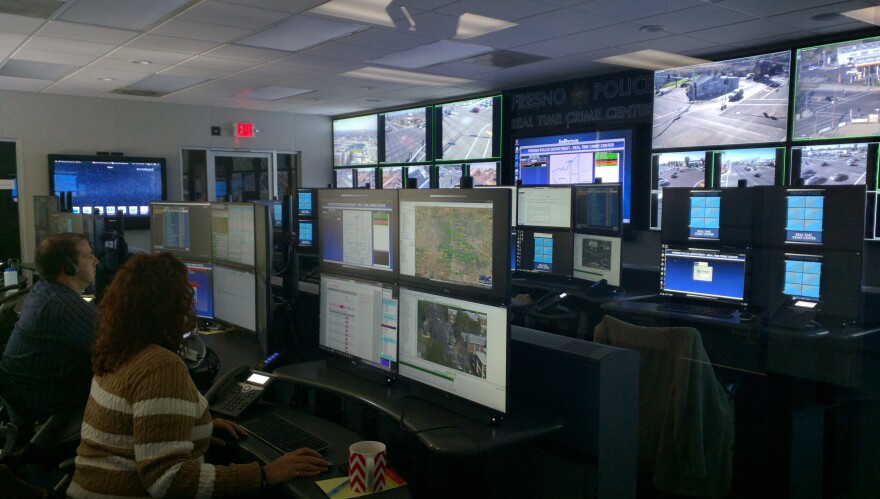How much privacy would you be willing to hand over to a police department in exchange for a promise of increased safety? Some say the Fresno Police Department is testing the very limits of that question with their Real Time Crime Center. Technology can help, but does it also have its limits?
There is a scene in the popular Batman movie The Dark Knight where Batman turns every cell phone in Gotham into one super surveillance network to help him hunt the Joker. His right-hand man Lucius explains the system this way:
“You took my sonar concept and applied to every phone in the city. With half the city feeding you sonar you can image all of Gotham,”
That is partly what I was expecting when I met Sergeant Steve Casto at the Real Time Crime Center in the Fresno Police Headquarters.

I found was something much less superhero and more nerdy. Casto says when he started his career it was all about being in the field. He never expected to monitor the city from behind a desk.
“We joke about that all the time. I can’t believe I am here and they didn’t teach this in the academy,” Casto laughs.
Casto oversees the technicians, mostly former cops or injured officers, who sit behind banks of monitors scanning all the information coming from the more than one thousand calls they get every day.
Large TVs line the walls displaying live footage from the hundreds of cameras around Fresno, a map tracks the position of every officer, and microphones around town listen for gun shots. The center collects tons of data all in one place. But, unlike Batman, they are not using cell phones as sonar.
And the inside is as quiet as a church.
When a call comes in, a technician sees it on a map, aggregates all the information they can access and shares it with the officer in the field.
“And there is one that just came in. You heard the alert ‘new call holding’ that alerts them that there is a new call holding. One of the operators in the center can assign themselves to a call. Take a look at that call. And then determine what they can offer the responding officers,” Casto said.

The department has extolled the advantages of speed and information the Real Time Crime Center provides. The details can be relayed to officers to ideally avoid the kind of miscommunication that led, in part, to the fatal shooting of a 12-year old boy with a toy gun in Cleveland, Ohio.
To Casto the center is highly effective.
One example he pointed to is a case where an officer got into a physical confrontation with a suspect and was unable to reach his microphone to call for help.
“However, the operator in the center, observing all this, saw that he was calling for help. Needed Help. And then was able to come over the radio to get him the help he needed to resolve the incident,” said Casto.
The Department has been aggressive in their use of electronic surveillance and information and in many cases is leading the way on modern policing.
But that ambition has twice gotten them into hot water with civil liberties and privacy advocates.
Matt Cagle, an attorney with the ACLU uncovered emails of the department testing a social network monitoring tool that advertised broad search capabilities.Cagle, an attorney with the ACLU uncovered emails of the department testing a social network monitoring tool that advertised broad search capabilities.

“Including a tool that encourages surveillance of hashtags like ‘black lives matter’, ‘don’t shoot’, and ‘I am unarmed’,” Cagle said.
In November, it was revealed that the department was using a third party software that assigned color-coded threat assessments when responding to calls.
Both programs have since been shelved.
Cagle thinks the department has been too aggressive and secretive with how it is applying electronic surveillance software.
“The real issue here is that law enforcement went and adopted and started using these technologies without looping in the public about the surveillance proposals and the proper safeguards and oversight that should be in place. So whether or not the community is OK with this should be up to the community not law enforcement to make the decision in secret,” Cagle said.
Sergeant Casto acknowledges that the department should have been more upfront about what they are doing. If any of the programs are revived he says they will explain it to the city council.
However, he remains adamant that the department should be monitoring the internet and social media like Facebook and Twitter for signs of criminal activity.
The evidence of how useful the cameras, internet searches and other high tech surveillance are is mixed says former prosecutor and Stanford law professor David Sklansky.
He says there is some research that shows cameras help reduce crime by securing convictions and deterring potential criminals. There is less research on the quality of information gleaned from social media, although it is currently legal for a department to do so.
However, he says police departments need to be wary of being seduced by the latest shiny technology.
“There is always a danger that technology can seem fun and sexy and easy. And a lot of what we know is important in policing is the hard work of getting out and getting to know the community and being in dialog with the community,” Sklansky said.
But all three men agree on one thing, the community at large is going to have to be more involved going forward when deciding how much privacy they are willing to sacrifice in the name of public safety.
After all, real life is not an action movie and Batman isn’t answer the call in Fresno any time soon.


